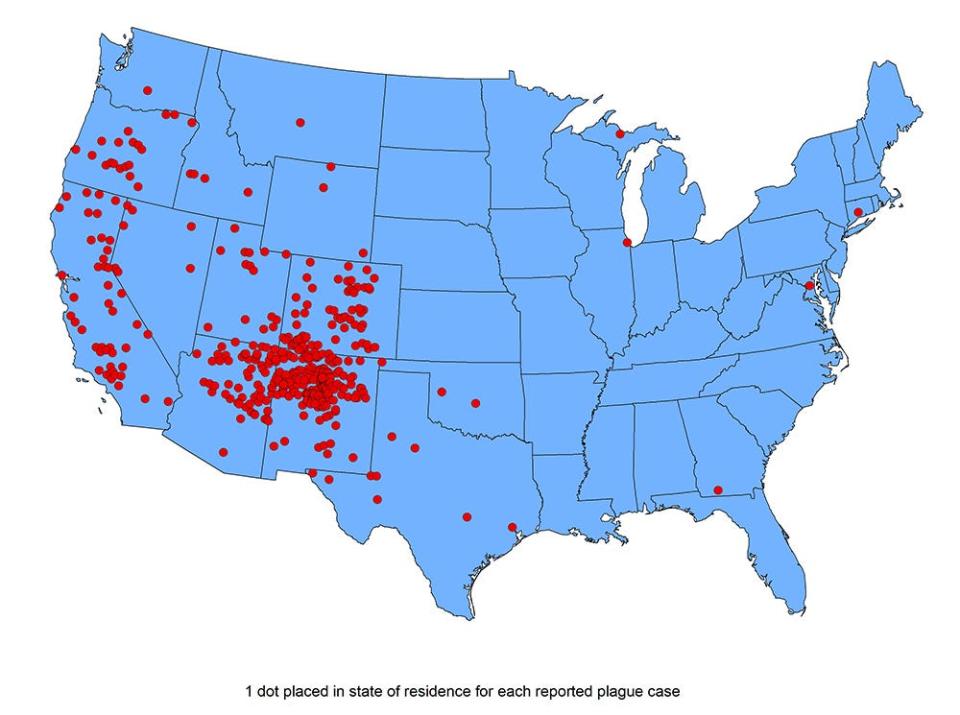Is bubonic plague a problem today? It did appear in this Florida city. Here's what we know
A case of bubonic plague has been reported in Oregon.
Although the Black Death devastated Europe in the 1300s, the plague does exist around the world today.
Cases of the plague also appear in the United States, according to the Centers for Disease Control.
In Florida, it's been more than a century since the last reported case, but the Florida Department of Health warned "the disease still remains a threat."
Here's what you should know about bubonic plague.
What is bubonic plague?
Plague is caused by the bacterium, Yersinia pestis, according to the CDC.
"Humans usually get plague after being bitten by a rodent flea that is carrying the plague bacterium or by handling an animal infected with plague."
In the recent Oregon case of the plague, the person was likely infected by a house cat.
How does bubonic plague spread?
Many animals — rock squirrels, wood rats, ground squirrels, prairie dogs, chipmunks, mice, voles, and rabbits — can be affected by plague. According to the CDC, it's transmitted to humans by:
Flea bites.
Contact with contaminated fluid or tissue.
Infectious droplets spread by coughing and inhaling the droplets.
How do cats get the plague?
"Cats are particularly susceptible to plague, and can be infected by eating infected rodents," the CDC said.
"Sick cats pose a risk of transmitting infectious plague droplets to their owners or to veterinarians. Several cases of human plague have occurred in the United States in recent decades as a result of contact with infected cats."
How many cases of plague are there in the US?

Presently, human plague infections continue to occur in rural areas in the western United States, but significantly more cases occur in parts of Africa and Asia, according to the CDC.
The plague was first introduced into the United States in 1900 by rat-infested ships arriving mostly from Asia.
The last urban plague epidemic in the United States occurred in Los Angeles from 1924 through 1925, the CDC said.
"Since then, all human plague cases in the U.S. have been sporadic cases acquired from wild rodents or their fleas or from direct contact with plague-infected animals," the Florida Department of Health said.
In recent decades, an average of seven human plague cases have been reported each year, the CDC said.
Most human cases in the United States occur in two areas:
Northern New Mexico, northern Arizona, and southern Colorado.
California, southern Oregon, and far western Nevada.
From 1970 to 2020, there were 496 reported cases of plague, the CDC said. The top states were:
New Mexico: 253
Colorado: 66
Arizona: 65
California: 45
Oregon: 19
When was the last time the plague appeared in Florida?

The last reported case of human plague in Florida occurred in 1920 during an outbreak in Pensacola, according to the Florida Department of Health.
The human plague victims were isolated and those who consented were treated with serum. Out of 10 total cases, seven victims died, according to Florida Memory, the State Library and Archives of Florida.
"Public health experts captured, examined and disposed of over 35,000 rats and mice from June 1920 to July 1921, carefully studying the fleas that came with them.
"The program’s final report gives 211 as the largest number of fleas found on a single rat, although the average was closer to about 10. City officials encouraged the public to do their share by trapping rats, covering them in oil to kill the fleas and turning them into the public health experts for processing," according to Florida Memory.
"Wherever rats infected with plague bacteria were found, a team followed behind to clean up whatever conditions had made the property attractive to them. The eradication program ultimately used 1,228 pounds of cyanide and 1,854 pints of sulphuric acid to fumigate buildings.
"The team also demolished seven houses and hauled 280 truckloads of trash and debris to the city dumps. The city government did its part to prevent future rodent infestations by passing new ordinances requiring business owners and residents to ratproof their buildings.
"Plank sidewalks, which offered rats and mice a convenient space to live, were outlawed and replaced with stone, brick or concrete. Under the new laws, incoming ships had to attach rat shields to their mooring lines, and ramps and gangplanks leading from the ship to the wharf had to be taken up when not in use," according to Florida Memory.
➤ Read about the plague from Pensacola Journal accounts in the Library of Congress.
Department of Health warns plague remains threat in Florida
"The disease still remains a threat.
"Even though plague is not currently in Florida, there is always the possibility that animals infected with Yersinia pestis may be imported into areas of the state that have suitable flea vectors."
Can you treat the plague? If you get it, can you survive?

Between 1900 and 2012, 1,006 confirmed or probably cases of human plague occurred in the U.S., the CDC said.
Plague is a very serious illness, but it is treatable with commonly available antibiotics. The earlier a patient seeks medical care and receives treatment, the better their chances are of a full recovery, the CDC said.
However, without prompt treatment, the disease can cause serious illness or death as the bacteria spreads to other parts of the body.
"If you live or have recently traveled to the western U.S. or any other plague endemic area and have symptoms suggestive of plague, seek health care immediately," the CDC said.
Symptoms of bubonic plague
The bubonic plague usually is caused by a bite from an infected flea. The bacteria multiply in a lymph node near where the bacteria entered the human body, the CDC said. The incubation period of bubonic plague is usually two to eight days.
Symptoms include:
Fever
Headache
Chills
Weakness
One or more swollen, painful lymph nodes (called buboes)
How many died of the Black Death?
The plague is infamous for killing millions of people in Europe during the Middle Ages, the CDC said.
Exactly how many millions of people died?
"The epidemic killed 30 percent to 50 percent of the entire population of Europe. "Between 75 million and 200 million people died in a few years’ time, starting in 1348 when the plague reached London," according to American Scientist.
In comparison, the U.S. Census Bureau estimates the 2023 population of the United States at just under 335 million. Estimated population of Florida as of July 1, 2023: 22.6 million.
Is a common nursery rhyme really tied to the bubonic plague?
Common folklore has it that the words in Ring Around the Rosie are referring to bubonic plague, with the words depicting the rash, flowers used to mask the smell of death and the final line referring to almost certain death.
Ring around the rosie
Pocket full of posies
Ashes, ashes we all fall down
The origins of the rhyme are lost in history and there are several different versions. Many experts doubt the connection to the plague. Some even have said the song is connected to courtship games, according to a Library of Congress blog.
This article originally appeared on Treasure Coast Newspapers: Bubonic plague: Pensacola outbreak, symptoms, states high risk, cases

